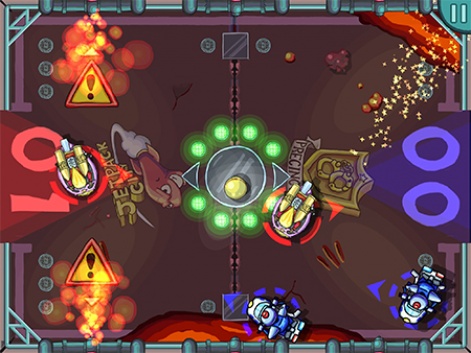It's never been so important to build your game for every device.
The advantages of positioning oneself as a solely mobile developer are arguably losing their power - certainly in 2013, with new platforms appearing all the time.
We've already had the launch of the Ouya, with GameStick and other micro-consoles set to appear soon. At the same time, the big daddies of the console market are gearing up for their major launches, with self-publishing initiatives on all three next-gen platforms.
Even small studios can get on these varied platforms by using cross-platform technologies such as Unity. Ignoring this engine - which seemingly exports to everything current and yet-to-come risks resulting in missed opportunities in the coming years.
But despite the potential of building a presence in every marketplace, does platform-agnostic development limit your studio's design opportunities?
Reaching new audiences
Building one game for multiple platforms isn't just about increasing the size of your audience. It's also about diversifying its nature.
PC and console gamers are passionate. They'll blog, chat on forums, make videos and follow press more actively than we expect mobile audiences to. This is the split between core and casual behaviour in action.
Building marketing momentum is difficult on mobile - a typically casual platform.
Enthusiastic early adopters on PC could give your game a publicity boost for a later mobile release. Indeed, micro-consoles may develop cult followings that become a fast-track to an enthusiast crowd.
However, simply being on all platforms isn't the same as making your mark on any of them. You still need some kind of killer attraction on at least one platform to make any traction at all.
Making a cross-device experience sing
So how do you find this best of both worlds? The biggest challenge is in creating great interfaces for both buttons and touch-screens, without compromising the complexity core gamers look for.
Point-and-click adventures and strategy games stand out as genres where touch and mouse control go hand-in-hand, but where a controller could be awkward.
Controller-based games are often tough to translate to mobile without a virtual D-pad. Gestures and multi-touch will translate neither to controller nor mouse.
However, the key to success among all input types isn't simplification. One-touch games, for example, should be compatible with every input system, but often fail to grab the hearts of core gamers due to their simplistic appearance.
An exception to the rule would be Super Hexagon, popular both on PC and on mobile. The game, while remarkably accessible, is ruthlessly difficult and frantically paced, attracting a hardcore competitive mentality.

Super Hexagon
What's more, its creator Terry Cavanagh had already built up credibility with the PC audience from core platformer VVVVVV. This meant his releasing an iOS game on PC was met with a level of trust that most mobile developers would not receive.
The lesson: a successful cross-platform game isn't just about great interface design. It needs to earn the trust of enthusiasts on each platform.
Restrictions on design
In my own work I've been focusing very strongly on shared-tablet multiplayer. That is, games where a touchscreen is shared between players and physical interaction is encouraged.
Games like Slamjet Stadium, my most recent iPad release, simply wouldn't be possible on a controller. Not without some serious design changes.
I don't regret doing things this way. The game allowed me to experiment with social play in a way I couldn't do otherwise. My gamble was rewarded, as the game was selected by Apple for New & Noteworthy in 61 countries - its unique use of the touchscreen was no doubt a contributing factor.
If every game tried to be platform-agnostic we wouldn't get unique experiences like Fingle or Draw Something, which rely on touch to operate. As a designer it's a shame to miss out on the creative possibilities that device-specific interfaces offer.
However, a game that fully exploits the unique features of one device limits its audience to users of that device. This means it may need to get featured by the platform-holder to be financially successful.
The advantages of single-device
Despite this, not every game needs to turn a direct profit to be a good business move.
A game that puts your studio on the map can pave the way for investment, and build respect for your brand in the eyes of platform holders. It can also give you a great press footprint ready for your next project.
With the acclaim received by Slamjet Stadium, I have a level of credibility that could help build publicity for my next game. The game has marked me out as a creator of surprising multiplayer experiences, which is a valuable banner to have.

Slamjet Stadium
Not only are new gaming platforms emerging, but new control interfaces too: Leap Motion, for example, and large-scale touchscreens on all-in-one PCs.
Meanwhile museums, and the growing range of public gaming showcases, provide an opportunity for developers to deliver unusual experiences that use these in exciting new ways.
Even if it cannot reach a large user base, a studio that uses unusual technology in innovative ways can use these spaces to mark itself out to tastemakers, press and clients.
Moving forwards in a cross-platform world
Ultimately, as a developer, both approaches to development are possible, and the best strategy could be a mix of the two.
If you want to open yourself up to new market opportunities as and when they appear, it's a no-brainer: make your games as cross-platform as possible.
Even for a game that relies on the specific features of one device, using a cross-platform engine gives you leverage to morph it into something new further down the line.
However, there's nothing wrong with focusing design on one platform. It may not have wide revenue potential, but using a device's unique features to showcase your team's creativity could pave the way for future success.
It's all about how you push it.






















